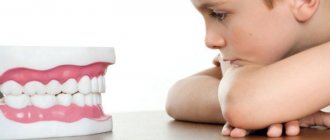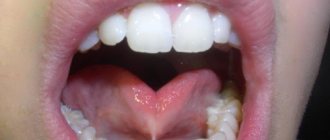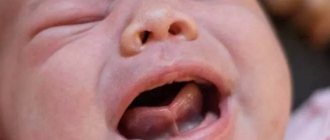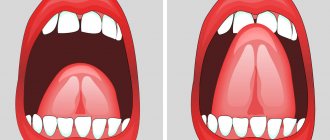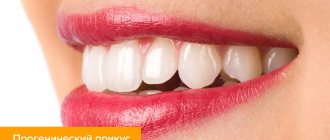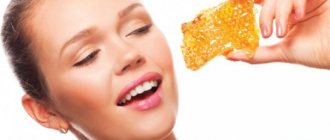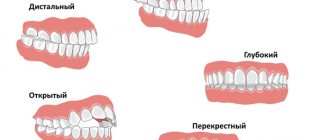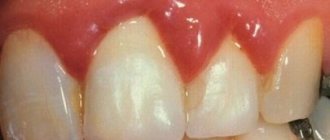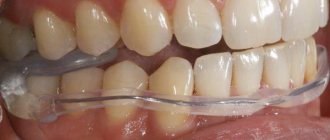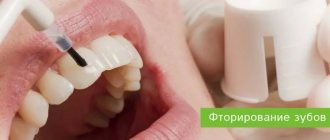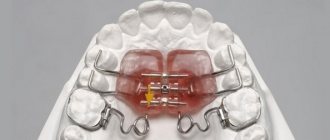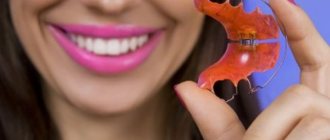8081
Orthodontic treatment does not always involve the use of special devices. In some situations, it is enough to use myogymnastics.
This option is an effective remedy for correcting abnormal bites , which has been proven by studies conducted over 50 years.
Exercises to normalize breathing function
Exercise No. 1 Full breathing. Take a long breath through your nose. During inhalation, the abdomen “inflates”, then the chest expands. When you exhale (through the nose), on the contrary, the volume of the chest first decreases, then the stomach retracts.
Exercise No. 2 Chest breathing. Exhale. Take a long breath through your nose. At this time, the chest expands and the stomach retracts. When you exhale (through the nose), the stomach retracts.
Exercise No. 3 Abdominal breathing. Exhale. Take a long breath through your nose. At this time, the stomach protrudes. When you exhale (through the nose), the stomach retracts.
Exercise No. 4 The skill of full, extended exhalation. Walk at an average pace. Inhale and exhale only through the nose. Inhale for three steps, exhale for four steps. After three to four days, the duration of exhalation should be increased by one count (5,6, etc.)
Exercise No. 5 Inhale and exhale alternately through one nostril (press the second nostril tightly with your finger).
Exercises to train the muscles of the tongue and normalize the type of swallowing
Exercise No. 1 “Clock”. The mouth is open, the tongue makes slow circular movements along the upper lip, then along the lower lip.
Exercise No. 2 “Punish the naughty tongue.” Place your tongue on your lower lip and slap it with your upper lip “na-na.”
Exercise No. 3 “We will paint the ceiling.” It's time to paint the rooms, they invited a molar, he comes to the old house with a new brush and bucket. Your tongues are a brush, your hard palate is the ceiling...
Exercise No. 4 Depict the operation of a jackhammer. DDDD...
Exercise No. 5 “Riders”. Sit astride a chair and, opening your mouth wide, click your tongue.
Causes of dental pathologies
Anomalies in the structure of the jaw and dental pathologies begin to form from birth. One of the reasons is the pacifier. However, abnormal formation of the jaw can also be caused by improper breathing through the mouth, as well as some bad habits. Thumb sucking is one of the persistent habits in children, which later leads to orthodontic pathologies.
Parents should pay special attention to forming the right habits in their child and weaning them from the wrong ones.
Breastfeeding forms the baby's correct bite by training the orbicularis oris muscle, tongue, and neck. Bottle feeding contributes to disruption of the maxillofacial muscles if the nipple has too large a hole.
The transfer to artificial feeding instead of breastfeeding may be due to reasons independent of the mother’s wishes. Therefore, carefully monitor the development of the baby’s jaw and show it to the dentist during the development. If the hole in the nipple is too wide, the baby gets full faster and stops sucking. Consequently, the muscles do not train and become weak.
Harm from pacifiers
How is a pacifier harmful to the formation of a bite? When sucking a pacifier, the tongue gets used to the incorrect position in the oral cavity. The tongue should be positioned on top of the nipple while sucking, but in babies everything happens the other way around. The lower position of the tongue (under the nipple) contributes to incorrect bite formation. In order not to spoil your baby’s bite, give him a pacifier as little as possible, and remove it from his mouth during sleep.
At the age of 1.5-2 years, the baby should be weaned off the pacifier so that the bite does not deteriorate.
Thumb sucking
Some babies try to replace the lack of a pacifier by sucking their thumb or the corner of a pillow. The child must be weaned from this habit immediately; it is even more harmful than sucking a pacifier. Sometimes the habit of falling asleep with your thumb in your mouth remains for life.
Thumb sucking leads to a very severe defect in the structure of the dental system, when the front teeth protrude forward and diverge to the sides. The bite is formed taking into account the position of the thumb between the lower and upper teeth, so there is an empty space. In addition to aesthetic dissonance, this arrangement of the frontal molars makes it impossible to bite food with the front teeth. Front teeth that are pushed forward are often susceptible to injury.
Mouth breathing
How can improper breathing affect the formation of the dental system? When breathing through the mouth, the pressure in the oral cavity that the cheeks exert on the upper row of teeth is disrupted. Because of this, the upper jaw arch narrows in size and the teeth grow crowded.
When should you pay attention to proper breathing? This must be done from the first days of the baby’s life and closely monitor his breathing while sleeping with a pacifier. As soon as the baby stops crying and falls asleep, the pacifier is immediately removed from the mouth. If you see that your baby has opened his mouth in a dream, carefully close it with your hand.
What to do if a child’s adenoids are enlarged and he cannot breathe through his nose? At this time, you need to make sure that mouth breathing does not become a habit. After healing from a runny nose and cold, you should monitor the child’s correct breathing during sleep and wakefulness. There is a special set of exercises to practice breathing through the nose after removal of the adenoids.
Lower lip suction
There is also a habit among children that subsequently negatively affects their appearance. Because of this bad habit, a gap is formed between the teeth, the size of which is equal to the thickness of the lower lip. Myogymnastics can correct an abnormal bite; hardware correction is also recommended.
Placing tongue between teeth
This bad habit leads to the formation of a gap between the upper and lower teeth. This gap corresponds to the size and shape of the tip of the tongue, which the child is accustomed to sticking forward. There is also a habit, invisible to adults, of placing the tongue between the chewing teeth (on the side). This pathology can only be noticed by a dentist.
As a result of incorrect position of the tongue in the oral cavity, the lateral molars sag and the bite is formed abnormally. The defect can be corrected with the help of functional devices and myogymnastics.
Improper swallowing
Doctors divide the swallowing function into conscious and uncontrolled. Correct swallowing should be noticeable only by the movement of the Adam's apple. If the facial muscles tense during swallowing, these are already symptoms of pathology. Improper swallowing leads to incorrect placement of molars in the dentition. If you notice that your child is swallowing food or drinking water in a special way, immediately take him to the orthodontist.
Exercises to normalize breathing function
Exercise No. 1 Full breathing. Take a long breath through your nose. During inhalation, the abdomen “inflates”, then the chest expands. When you exhale (through the nose), on the contrary, the volume of the chest first decreases, then the stomach retracts.
Exercise No. 2 Chest breathing. Exhale. Take a long breath through your nose. At this time, the chest expands and the stomach retracts. When you exhale (through the nose), the stomach retracts.
Exercise No. 3 Abdominal breathing. Exhale. Take a long breath through your nose. At this time, the stomach protrudes. When you exhale (through the nose), the stomach retracts.
Exercise No. 4 The skill of full, extended exhalation. Walk at an average pace. Inhale and exhale only through the nose. Inhale for three steps, exhale for four steps. After three to four days, the duration of exhalation should be increased by one count (5,6, etc.)
Exercise No. 5 Inhale and exhale alternately through one nostril (press the second nostril tightly with your finger).
Exercise No. 6 Exhale. Pinch your nose with your fingers. Slowly count out loud to 5, then take a deep breath and exhale through your nose.
Exercises to strengthen the pharyngeal muscles
Exercise No. 1 Alternately tilt your head back as much as possible, leaning forward.
Exercise No. 2 Throw your head back. In this position, alternately tilt your head towards the right and left shoulder.
Exercise No. 3 Throw your head back, in this position alternately turn your head, without releasing your chin, to the right, then to the left.
Dental alternative - selection of aligners
If you decide to entrust your smile to professionals, remember: it is the patients who decide to resort to the help of orthodontists and get aligners that manage to get the coveted beautiful smile and eliminate bite defects at home.
In this case, there is no need to perform complex manipulations or exercises: it is enough to select aligners under the supervision of a doctor and follow the recommendations of a specialist, and the aligners will do the rest themselves!
Exercises to normalize the function of lip closure
Exercise No. 1 Pull your lips forward, close them, draw a tube, and stretch them wide.
Exercise No. 2 Pull your lips forward, close them, depict a mouthpiece, a proboscis.
Exercise No. 3 Close your lips, puff out your cheeks, slowly squeeze the air through your clenched lips with your fists.
Exercise No. 4 Close your lips, then move them alternately to the right and left.
Exercise No. 5 Close your lips, blow air under your upper lip, then under your lower lip.
Exercise No. 6 Place bent little fingers in the corners of the mouth, do not close your lips, spread your fingers slightly to the sides, close your lips.
Exercise No. 7 Blow out a stream of air with force (“a breeze is blowing,” let’s put out the candle,” “let’s make a storm,” etc.).
Exercises to train the muscles of the tongue and normalize the type of swallowing
Exercise No. 1 “Clock”. The mouth is open, the tongue makes slow circular movements along the upper lip, then along the lower lip.
Exercise No. 2 “Punish the naughty tongue.” Place your tongue on your lower lip and slap it with your upper lip “na-na.”
Exercise No. 3 “We will paint the ceiling.” It's time to paint the rooms, they invited a molar, he comes to the old house with a new brush and bucket. Your tongues are a brush, your hard palate is the ceiling...
Exercise No. 4 Depict the operation of a jackhammer. DDDD...
Exercise No. 5 “Riders”. Sit astride the toilet seat and, opening your mouth wide, click your tongue.
Exercise No. 6 Lift the tongue up, press it to the front part of the hard palate in the area of the palatine folds. Clench your teeth, swallow saliva, fixing the position of your tongue.
Exercise No. 7 Raise the tip of the tongue up and place it at the anterior part of the hard palate. Move the tongue along the arch of the hard palate as far back as possible to the soft palate.
Exercise No. 8 Raise the tip of the tongue up and place it at the anterior part of the hard palate. Move your tongue along the palatal surface of the teeth on the right and left, touching each tooth.
What it is?
The bite is formed due to the proper functioning of the muscles located in the area of the dentition and jaw joint. Any disturbance in their functioning leads to the formation of an abnormal position of the teeth and jaw arch.
The main goal of myotherapy is to restore the proper functioning of the joint and muscle system by influencing them using regular exercises, sometimes in combination with massage. At its core, myogymnastics is training the jaw muscles.
It is advisable to prescribe the technique as a comprehensive or independent treatment. It is also used to consolidate the effect after hardware orthodontic treatment or as a preparatory procedure before it.
Treatment principle
The principle of treatment of this technique is the complexity of the effect.
Under the influence of active motor exercises, improvement occurs due to four physiological mechanisms :
- Biological stimulation of bone tissue growth and muscle development.
- Formation of a compensating mechanism.
- Positive effect on trophic processes.
- Normalization of functional characteristics.
Under the influence of these processes, there is an active restructuring of muscle function and skeletal development towards anatomical balance.
Exercises to normalize breathing function
Exercise No. 1 Full breathing. Take a long breath through your nose. During inhalation, the abdomen “inflates”, then the chest expands. When you exhale (through the nose), on the contrary, the volume of the chest first decreases, then the stomach retracts.
Exercise No. 2 Chest breathing. Exhale. Take a long breath through your nose. At this time, the chest expands and the stomach retracts. When you exhale (through the nose), the stomach retracts.
Exercise No. 3 Abdominal breathing. Exhale. Take a long breath through your nose. At this time, the stomach protrudes. When you exhale (through the nose), the stomach retracts.
Exercise No. 4 The skill of full, extended exhalation. Walk at an average pace. Inhale and exhale only through the nose. Inhale for three steps, exhale for four steps. After three to four days, the duration of exhalation should be increased by one count (5,6, etc.)
Exercise No. 5 Inhale and exhale alternately through one nostril (press the second nostril tightly with your finger).
How to speed up results
Often, children with the same orthodontic disorders experience different dynamics in the quality of treatment. As experts note, this is not about the characteristics of the child’s body, but about the correctness of performing gymnastics and following all the doctor’s recommendations.
To increase the effectiveness of myogymnastics, parents need to remember the following basic rules:
- Increase the duration and intensity of muscle contractions gradually but regularly.
- Increase muscle contraction to the maximum.
- Do all exercises until fatigue appears.
- Maintain breaks between muscle contractions. The duration of such a pause should always be equal to the duration of the squeeze.
- Carry out gymnastics every day at the same time.
Additional special exercises
Exercise No. 1. Slowly push the lower jaw forward until the cutting edges of the lower incisors are positioned in front of the upper ones. Hold the lower jaw in this position for 10 seconds, then slowly return to its original position.
Exercise No. 2. Perform the same exercise with a spank of the head, first to the right, then to the left. The load increases when performing the exercise while standing. The head is slightly tilted back, the lower jaw is slowly pushed forward until the lower incisors are positioned in front of the upper ones.
Exercise No. 3 (with the vestibular plate). The vestibular plate is placed in the vestibule of the oral cavity, with 1 finger of the right hand it is pulled forward by the ring and held with pursed lips.
Exercise No. 4. Place a folded strip of paper between your lips and purse your lips. The paper is held for up to 30-50 minutes during quiet games, drawing, reading, or when the child is watching TV.
Exercise No. 5. Perform the previous exercise, replace the strip of paper with a metal disk with a diameter of 2.5-3 cm, a thickness of 1.5 mm and a mass of about 6.5 g. The disk clamped between the lips should be positioned horizontally, it is necessary to ensure that the disk is only clamped lips, not teeth. The exercise is performed until fatigue (from 30 seconds to several minutes).
Exercise No. 6 (with a plastic plate). The child presses the edge of the plate, 1-2 mm thick and 30-35 mm wide, with his lips. 60-120 mm long. and holds it in a horizontal position. Some kind of weight is placed on the plate. Increasing the load causes increased clenching of the lips.
Exercise No. 7. Small cotton rolls are placed in the area of the transitional fold of the vestibule of the oral cavity on both sides of the frenulum of the upper lip. Close your lips and pronounce a series of phrases containing labial sounds (“b”, “m”, “p”).
Indications and contraindications
Indications for prescribing myogymnastics are:
- various types (distal, mesial, etc.) of degree I malocclusion;
- uneven placement of crowns;
- hypotonicity of the facial muscles;
- dysfunction of the TMJ (Rokabado myogymnastics);
- dysfunction of the circular muscles of the mouth and tongue.
Myotherapy cannot be used in a number of cases :
- pathological hypertrophy of the facial muscles;
- poor mobility of the jaw joint;
- abnormal bite III degree;
- disorders of jaw development due to previous common diseases, for example, rickets.
How can it be used?
Depending on the initial diagnosis, myotherapy can be prescribed as independent therapy or combined with other correction methods.
As a rule, complex bites require complex treatment, and along with gymnastics, hardware correction is used using removable or non-removable orthodontic devices.
For mild anomalies in early childhood, it may be sufficient to use exercises alone. Only if they are ineffective, hardware correction is performed after 2–3 months.
If gymnastics is prescribed to eliminate myofunctional habits, then special devices are often used to perform the exercises : a vestibular plate and a metal disk.
Who is it suitable for?
This technique is primarily aimed at treating children aged 4 to 8 years during the period of primary malocclusion. The jaw at this age is not fully formed and lends itself well to correction.
It is also permissible to carry out treatment with the help of exercises for children after 9 and up to 12 years , when active teeth change occurs. But the therapy in this case will be longer.
To correct the dentofacial apparatus in adulthood, myogymnastics is rarely used, since it gives minimal effect.
Exercises to normalize breathing function
Exercise No. 1 Full breathing. Take a long breath through your nose. During inhalation, the abdomen “inflates”, then the chest expands. When you exhale (through the nose), on the contrary, the volume of the chest first decreases, then the stomach retracts.
Exercise No. 2 Chest breathing. Exhale. Take a long breath through your nose. At this time, the chest expands and the stomach retracts. When you exhale (through the nose), the stomach retracts.
Exercise No. 3 Abdominal breathing. Exhale. Take a long breath through your nose. At this time, the stomach protrudes. When you exhale (through the nose), the stomach retracts.
Exercise No. 4 The skill of full, extended exhalation. Walk at an average pace. Inhale and exhale only through the nose. Inhale for three steps, exhale for four steps. After three to four days, the duration of exhalation should be increased by one count (5,6, etc.)
Exercise No. 5 inhale and exhale alternately through one nostril (press the second nostril tightly with your finger).
Exercises to train the muscles of the tongue and normalize the type of swallowing
Exercise No. 1 “Clock”. The mouth is open, the tongue makes slow circular movements along the upper lip, then along the lower lip.
Exercise No. 2 “Punish the naughty tongue.” Place your tongue on your lower lip and slap it with your upper lip “na-na.”
Exercise No. 3 “We will paint the ceiling.” It's time to paint the rooms, they invited a molar, he comes to the old house with a new brush and bucket. Your tongues are a brush, your hard palate is the ceiling...
Exercise No. 4 Depict the operation of a jackhammer. DDDD...
Exercise No. 5 “Riders”. Sit astride a chair and, opening your mouth wide, click your tongue.
Main directions
The list of functions performed by an orthodontist includes:
- adjustment of the position of individual elements;
- correction of bite and occlusion;
- carrying out prevention of violations.
Before starting orthodontic procedures, the dentist examines and diagnoses the patient’s condition, determining the measures necessary to restore the natural appearance. Orthodontics in dentistry helps to correct noticeable deviations, preventing and eliminating the consequences of various diseases.
Additional special exercises
Exercise No. 1. Use the tip of your tongue to press on the palatal surfaces of the upper front teeth until the muscles are tired (3-5 minutes).
Exercise No. 2. With the head thrown back, alternately open and close the mouth; when closing the mouth, try to reach the back edge of the hard palate with the tip of the tongue.
Exercise No. 3. Pinch your lower lip with your upper front teeth, hold it, then release it.
Exercise No. 4. Open your mouth, slowly close it, sweeping the lower jaw back and placing the front teeth in marginal closure. Hold the lower jaw in this position for 4-8 seconds.
Exercise No. 5 (with a wooden spatula). A spatula is placed between the teeth (its width is equal to the width of the upper incisors).
Bite the spatula so as to apply pressure on the palatal surfaces of the upper teeth and promote their deflection in the vestibular direction, and the lower incisors in the lingual direction.
At what age should you start correcting your bite?
Dentists believe that occlusion correction can be carried out at any age using appropriate techniques. Thus, children are not treated with braces because their skeletal system is in active growth, and the bones, including the dentofacial apparatus, have not yet formed. Therefore, young children, before they have permanent teeth yet, are treated with myotherapy, plates and trainers. Note: such methods are used in the presence of non-critical developmental defects. Complex congenital pathologies that have a negative impact on the health or quality of life of the baby are treated surgically.
The optimal period of treatment with braces is from approximately 12 to 16 years. At older ages, the process takes longer.
Important: some dental anomalies can be corrected without the use of braces. The possibility of such treatment is determined by the doctor.
